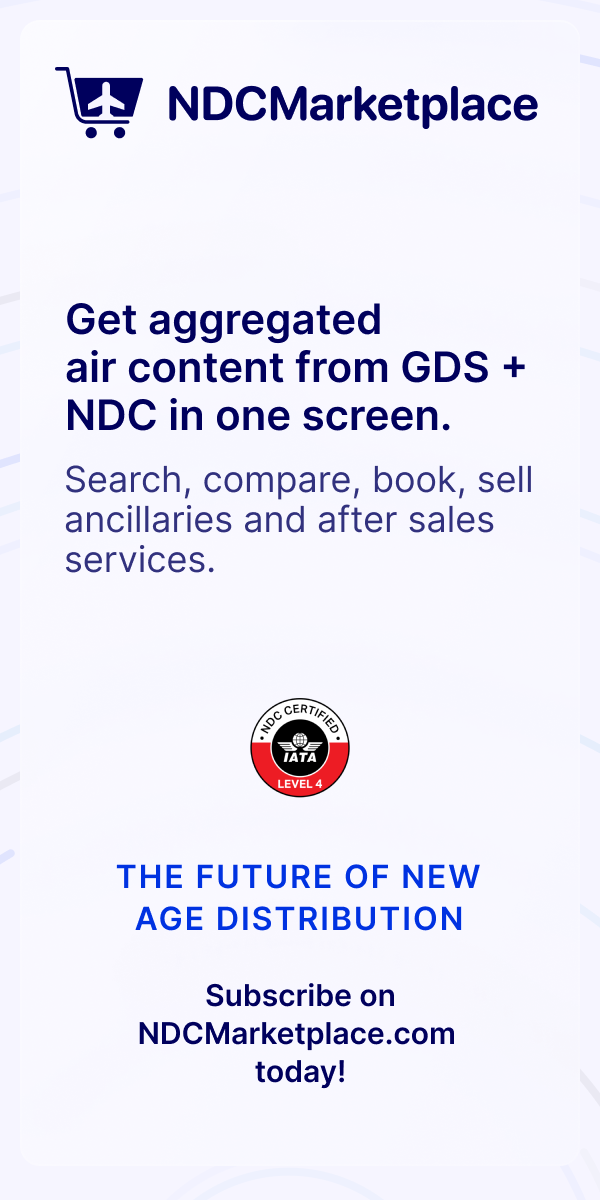Strengthening its position within the NDC framework, Sabre Travel has announced that they are in talks for a new distribution agreement with Qatar Airways, which will enable them to push the airline’s rich NDC content through the Sabre travel marketplace.
This new agreement will be a huge milestone for Sabre’s vision for personalized travel with IATA’s New Distribution Capability (NDC). The agreement will allow travel agents access to Qatar Airways’ rich content, easily and efficiently through the Sabre GDS, while Qatar Airways, who recently won the Airline of the Year 2021 award by AirlineRatings, will have access to unlimited retailing possibilities through Sabre.
Arabiatravelnews.com spoke to Dino Gelmetti, VP & GM – EMEA for Sabre Travel Solutions about this new collaboration and how their distribution program is evolving with the NDC standard.
With Emirates’ discontinuing its Sabre partnership, how have conversations changed with your airline partners?
We are currently in the process of finalizing a new distribution agreement with Qatar Airways which will provide long-term, competitive, access to the airline’s content through the Sabre travel marketplace. Implementation work will enable Qatar Airways’ NDC offers to be distributed through the Sabre GDS marketplace, which today has a network of more than 425,000 travel agents.
So, I would say the conversations have taken other directions on how to incorporate NDC to achieve best outcomes. We are in active conversations with more than 25 airlines about distributing their NDC content through Sabre and interest continues to increase.
Sabre concludes more than one hundred airline distribution agreements each year. Our recent announcements include agreements with global carriers such as Delta Air Lines, Virgin Australia, Lufthansa Group and American Airlines, to name a few. We are keen to find a solution that works within our airline partners’ strategies and also delivers incremental value to the other stakeholders in the travel value chain.
We also continue to be actively engaged with Emirates. We believe that fully integrated access to broad and deep travel content provides immense value to all parties in the ecosystem. We value Emirates’ content and hope to reach an agreement in the future that meets the needs of all parties – the airline, travel agencies, travelers, and Sabre.
How has Sabre evolved within the NDC framework? What is on the agenda for the next 5 years?
For many years, even before NDC gained traction, Sabre was enabling airlines to sell their products in new and differentiated ways through both direct and indirect channels. In fact, Sabre has led the industry in this arena: we delivered the first branded fares and paid seat solution for airlines. We launched the availability of American Airlines’ paid seats through the Sabre travel marketplace using XML-based technology standards in 2015. This launch represented both companies’ first implementation of ancillary sales through a GDS.
So, when NDC emerged as a formal initiative from IATA, it wasn’t a new concept for us. We were able to weave it more formally into our innovation efforts without missing a beat. Going Beyond NDC is a corporate priority for us as a key enabler of our vision to create the leading marketplace for personalized travel. It’s all about ensuring travelers can access the right offer, at the right time, through the right channel. Not only are we meeting the letter of the NDC standards, but we’re also ensuring our capabilities scale across end-to-end workflows so that they deliver the robust, secure and dependable capabilities that our customers need.
As evidence of our commitment, we’ve continued to make significant progress going beyond NDC despite COVID-19 headwinds. The prime booking flow, including servicing, is live, meaning customers can shop, book and service NDC content through Sabre via our Offer and Order APIs and Sabre Red 360.
The sun never sets on NDC at Sabre as we have activated nearly 50 markets around the world across five airlines, including American Airlines, Finnair, Qantas Airways, Singapore Airlines and United Airlines. In addition to these airlines, we are in discussions with over 25 additional airlines to distribute their NDC offers.
Corporate customers that use our GetThere online booking tool to support business travelers are also piloting NDC offers in GetThere. Our NDC capabilities on both the aggregator and airline IT sides of the NDC equation are both IATA NDC Level 4 certified, which signals to customers that we can support robust offer and order management capabilities. Bottom line: NDC is live at Sabre.
While our progress is exciting, we’re equally energized about what’s to come. In addition to rolling out additional capabilities, more branded and ancillary content, airlines and markets in the coming years, we will continue to engage in various IATA working groups to help define the NDC standards. The full set of use cases that the industry is accustomed to, for EDIFACT is not yet fully fleshed out for NDC. Given Sabre’s position at the crossroads of travel, we’re able to encourage all perspectives to be considered. In summary, in the coming five years, we will see more innovation that delivers personalization, greater choice and distribution consistency.
What have been your biggest challenges and learnings as operations evolved with the adoption of NDC?
I would highlight two main challenges and a key lesson learned:
In terms of challenges, we’ve put in a lot of work to expand industry thinking about NDC. By that I mean, airlines were initially enthusiastic about NDC related to shopping and how it supports access to innovative content. Of course, that is incredibly important, but focusing on shopping alone isn’t enough to drive adoption among sellers and other intermediaries. We’ve been advocating to zoom out and take a more holistic view across end-to-end workflows, including mid and back-office integrations. We’ve seen the benefits of this approach in removing technical hurdles to adoption, which ultimately will benefit the industry overall.
A second challenge has been the need to educate partners and customers about NDC: what it is, what it isn’t, and what it can be. NDC is a maturing topic, so it’s challenging to distill hype from reality. What appears on paper does not necessarily translate into robust functionality that truly meets customer needs. Furthermore, NDC has been conflated with being a commercial model, when in fact, it is a technical standard. While some airlines are introducing new commercial terms in conjunction with their NDC content, that is not a given and airlines will vary. At Sabre, we’re committed to enabling capabilities that truly scale with a customers’ needs.
Finally, in terms of a key lesson learned, our experience has taught us that NDC is a team sport; we can’t do it alone. This relates to the challenges I mentioned. We can’t work in silos on NDC and expect progress. Delivering NDC-enabled retailing, distribution and fulfilment solutions requires input and collaboration from players across the travel ecosystem. A partnership-driven approach to ensure positive outcomes has been part of our strategy from the start.
What kind of dynamic offers are you seeing from airlines? Is rich content living up to the hype?
I believe we are not at the end of the NDC journey. It is not even the beginning of the end. But, it is, perhaps, the end of the beginning. By that I mean that basic NDC workflows are nearing completion across the industry and are becoming more widely available. We’ll collectively start looking toward the adoption of NDC at scale. Differentiated content is one of multiple drivers of demand.
It’s early days in terms of seeing the full breadth of potential content that will flow through NDC pipes. We are encouraged to see airlines experimenting more with dynamic content, particularly related to seats and frequent flier numbers. We look forward to seeing how airlines will continue to diversify the type of offers they create as the NDC standards mature. We would encourage sellers, technology providers and corporations to continue to discuss the topic of differentiated content with airlines.
Can we expect to see new customers from the region – whether national carriers or LCCs?
The Middle East region represents a great opportunity for technology adoption. With the increasing appetite to travel, strong interest in personalization and demand for differentiated offerings, airlines in the Middle East are set to evolve further to cater to the expectations of savvy travelers.
We are in discussions with many leading airlines and LCCs to help them navigate through the travel recovery. As I noted, those NDC discussions include Qatar Airways and Emirates, among others.


